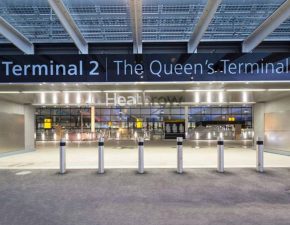Heathrow Airport Terminal 2 Taxiway

Site:
Heathrow Airport is the largest Airport in Europe and the third largest, in terms of passenger traffic, in the world. Originally opened as a small airfield in 1929, Heathrow’s first expansion was commissioned in 1944 in a bid to support the war effort and host military aircraft bound for the Far East. By the time of its opening in 1946, war had ended and was therefore developed as a civilian airport named London Airport. The name was changed to London Heathrow Airport in 1966. In 2014, Terminal 2, officially known as The Queen’s Terminal, re-opened following a four-year renovation programme and in 2016, reparation works to 1750m² of the existing concrete block paving on Terminal 2’s taxiway was completed.
Challenge:
With 16.5 million passengers travelling through Terminal 2, representing 21.8% of all passenger traffic in 2016, a sealer was required to help prevent paver destabilisation due to weight of aircraft, and its movement across the Terminal taxiway. Protection against fuel infiltration was also specified.
Solution:
Resiblock selected its Resiblock ‘22’ sealer as the sealer of choice, due to its historical success at major international Airports, including Glasgow Airport, Scotland, Christchurch Airport, New Zealand, Sapporo Airport, Japan and Hong Kong International Airport. The success at Hong Kong International Airport was one of the key reasons for selecting Resiblock ‘22’, as it is one of only two Airports in the world that are bigger than London Heathrow Airport (in terms of Passenger Traffic). Resiblock ‘22’ is a commercial grade joint stabiliser which prevents both water and fuel infiltration but additionally stabilises the jointing sand, preventing erosion from cleaning regimes and aircraft movement.
Resiblock ’22’ Benefits:
Resiblock ‘22’ is a specialist pre-polymer urethane (SPPU) which prevents the erosion of jointing sand. The areas sealed were completed in controlled sections in a few hours and heavy traffic was reinstated shortly afterwards, ensuring minimum disruption to the airport.
- One pack material
- Easy application
- Prevents sand erosion from paver joint
- Prevents the ingress of water and fuel infiltration to the sand laying course
- Maintains structural stability under heavy duty trafficking
- Elastomeric bond works in tandem with paver system
- Case Study
- Project name: Heathrow Airport Terminal 2 Taxiway
- Client: George Lines Builders Merchant
- Contractor: The Shannon Group
- Site: Heathrow Airport
- Area: 1750m²
- Paver type: Concrete Block Paving 200x100mm
- Product/s: Resiblock '22'
- Date: March 2017
- Download PDF
